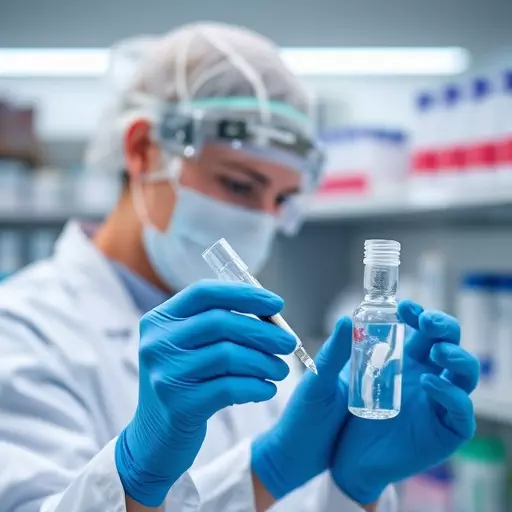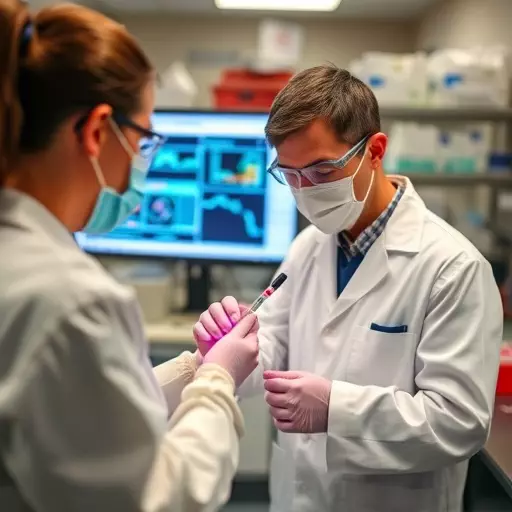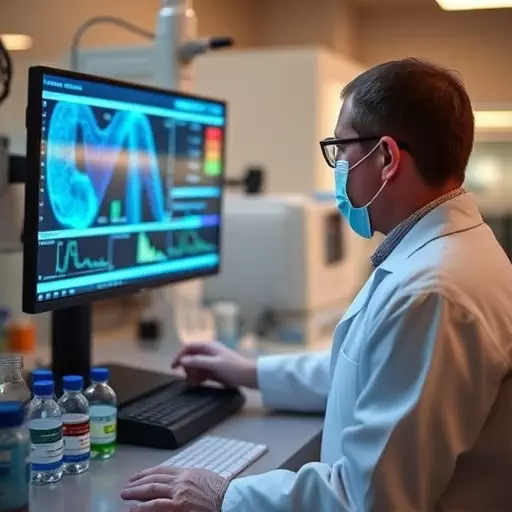In Cincinnati, technological advancements and heightened safety standards are reshaping the field of laboratory work. UV sterilization robots are emerging as a key solution to maintain pristine environments, facilitate rapid innovation, and ensure accuracy in critical areas like cancer diagnostics. Integrating with real-time lab result reporting and liquid biopsy techniques, these robots enhance efficiency, improve decision-making, and revolutionize patient care by providing actionable insights into unique tumor profiles. The combination of UV sterilization and advanced reporting methods promises to further develop and accelerate progress in Cincinnati's medical community, particularly in cancer treatment.
The demand for safe and efficient lab work in Cincinnati’s thriving research community is on the rise. As such, the development of UV sterilization robots emerges as a game-changer, addressing the growing need for enhanced lab safety. This article explores these innovative robots, their technology, and impact on efficiency. We delve into advances in real-time lab result reporting and how liquid biopsy, a revolutionary cancer diagnostics approach, can benefit from this automation. Discover how UV sterilization robots are transforming lab practices and shaping the future of research in Cincinnati.
- The Growing Need for Lab Safety and Sterilization in Cincinnati's Research Scene
- Understanding UV Sterilization Robots: Technology and Functionality
- Advances in Real-Time Lab Result Reporting and Their Impact on Efficiency
- Liquid Biopsy: A Revolutionary Approach to Cancer Diagnostics
- Integrating UV Sterilization Robots for Enhanced Lab Safety and Future Prospects
The Growing Need for Lab Safety and Sterilization in Cincinnati's Research Scene

In Cincinnati, the landscape of lab work is evolving rapidly, driven by advancements in technology and a growing emphasis on safety and sterilization. As research continues to push boundaries, particularly in areas like biotechnology and medical innovation, ensuring a clean and controlled environment becomes paramount. The city’s research scene is witnessing an unprecedented surge in demand for precise, efficient, and reliable sterilization methods to safeguard against potential contaminants.
This need is further amplified by groundbreaking developments such as real-time lab result reporting and the increasing application of liquid biopsy in cancer diagnostics. These advancements require not just enhanced sterility but immediate access to accurate results. UV sterilization robots emerge as a game-changer in this context, offering a proactive approach to maintain a pristine laboratory environment, thereby fostering innovation without compromising on safety or efficiency.
Understanding UV Sterilization Robots: Technology and Functionality

UV sterilization robots are revolutionizing lab safety and efficiency, especially in light of advances in real-time lab result reporting. These innovative machines utilize ultraviolet (UV) light to kill bacteria, viruses, and other pathogens, ensuring a sterile environment crucial for accurate lab work in Cincinnati and beyond. The technology behind these robots involves advanced sensors and automation, enabling them to navigate through laboratory spaces and target surfaces with precise UV exposure.
By integrating liquid biopsy techniques, UV sterilization robots further enhance cancer diagnostics. Liquid biopsies, which involve analyzing circulating tumor DNA, offer non-invasive ways to detect and monitor cancer progressions. As these methods gain traction, the need for stringent environmental sterility becomes even more critical. UV robots ensure that lab equipment and surfaces remain free from contaminants, thereby upholding the integrity of liquid biopsy results and contributing to improved healthcare outcomes in Cincinnati’s medical community.
Advances in Real-Time Lab Result Reporting and Their Impact on Efficiency

The development of UV sterilization robots is a significant step forward in ensuring lab safety, especially in bustling environments like those found in Cincinnati’s lab work facilities. Advances in real-time lab result reporting have played a crucial role in enhancing efficiency within these laboratories. With the integration of cutting-edge technology, scientists can now receive immediate feedback on their experiments and analyses, eliminating delays previously caused by manual data collection and processing. This rapid reporting system allows for quicker decision-making, enabling researchers to optimize protocols and improve overall productivity.
In terms of impact, real-time lab result reporting has revolutionized the way data is handled, especially in cancer diagnostics where liquid biopsy techniques are transforming traditional approaches. By streamlining the reporting process, labs can efficiently manage vast amounts of information, ensuring accurate and timely insights into disease states. This advancement complements the use of UV sterilization robots by fostering a cleaner, safer working environment, ultimately contributing to the development of more effective healthcare solutions.
Liquid Biopsy: A Revolutionary Approach to Cancer Diagnostics

In recent years, a revolutionary approach to cancer diagnostics has emerged through advances in liquid biopsy technology, offering significant benefits for lab work in Cincinnati and beyond. Unlike traditional tissue biopsies that require invasive procedures, liquid biopsy involves the analysis of free-circulating tumor DNA (ctDNA) and other cellular components present in a patient’s blood. This minimally invasive technique not only speeds up diagnosis but also enables real-time monitoring of cancer progression and treatment response.
With rapid advancements in molecular diagnostics and next-generation sequencing, liquid biopsy transforms cancer diagnostics by providing actionable insights into an individual’s unique tumor profile. The ability to detect minimal residual disease early on enhances patient management, improves prognostic accuracy, and paves the way for personalized treatment strategies. This innovative approach is transforming lab work in Cincinnati, empowering healthcare professionals to deliver more effective and efficient care to cancer patients.
Integrating UV Sterilization Robots for Enhanced Lab Safety and Future Prospects

The integration of UV sterilization robots into lab work environments in Cincinnati and beyond represents a significant step forward in enhancing safety protocols. These advanced robots play a pivotal role in ensuring sterile conditions, particularly crucial for high-precision tasks and research that demands minimal contamination. By leveraging real-time lab result reporting technologies, these systems enable researchers to monitor environmental cleanliness instantly, fostering more efficient and secure lab practices.
Looking ahead, the future prospects of UV sterilization robots are promising, especially with the ongoing developments in liquid biopsy technology transforming cancer diagnostics. As advancements continue, these robots could become even more sophisticated, providing comprehensive disinfection solutions tailored for diverse laboratory settings. This evolution promises to streamline lab work processes, improve overall safety, and expedite groundbreaking research, including the critical area of cancer treatment innovations driven by liquid biopsy insights.
